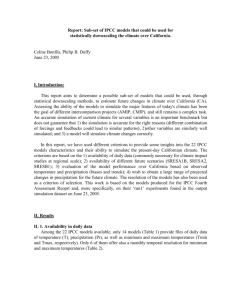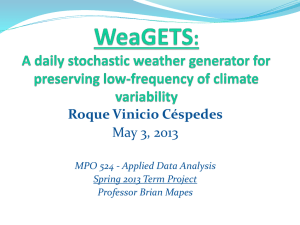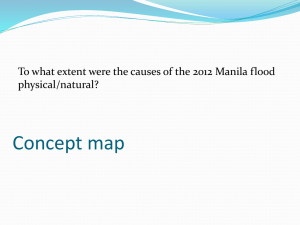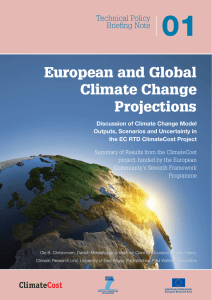Climate change effects on extreme precipitation in Morocco.
advertisement
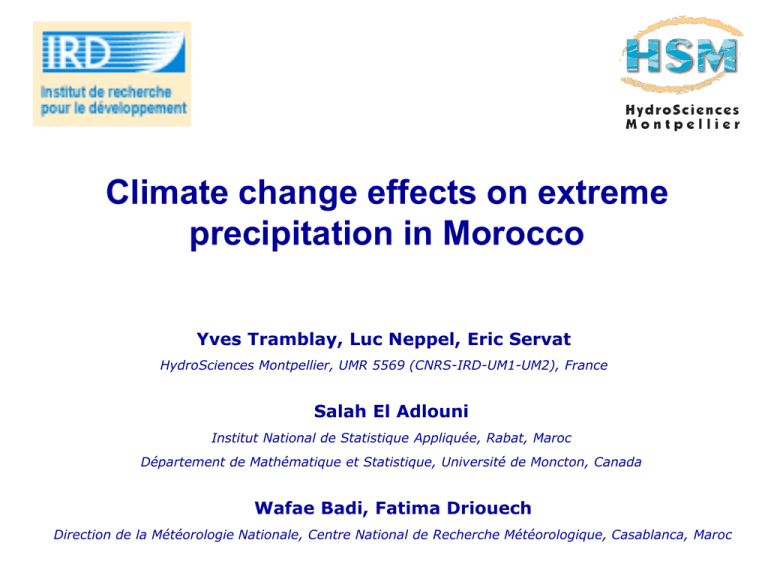
Climate change effects on extreme precipitation in Morocco Yves Tramblay, Luc Neppel, Eric Servat HydroSciences Montpellier, UMR 5569 (CNRS-IRD-UM1-UM2), France Salah El Adlouni Institut National de Statistique Appliquée, Rabat, Maroc Département de Mathématique et Statistique, Université de Moncton, Canada Wafae Badi, Fatima Driouech Direction de la Météorologie Nationale, Centre National de Recherche Météorologique, Casablanca, Maroc Objectives Morocco is often hot by intense rainfall events, causing human losses and economic damages (ex. Ourika, 1995, Rabat, Casablanca, Tanger, 2009) Goals of the study: 1- Evaluate the past trends in the observed extreme precipitation records and the dependences with circulation indexes (NAO, MO) 2- Evaluate the possible future trends with outputs of different Regional Climate Models (RCM) from the ENSEMBLE project (www.ensembles-eu.org) 1- Datasets and methods Meteorological stations Daily precipitation between 1960 and 2007 Global and Regional Climate Models • Higher spatial resolution = better description of orography • Responds in a physically consistent way to different forcings • Better reproduce extreme events than GCMs (Frei, 2006, Fowler, 2007) • Dependent on the boundary conditions imposed by the parent GCM • Requires advanced computing resources Extreme value models Extreme Value Distribution (GEV) with 3 parameters (µ,α,κ): 1/ F ( x) exp 1 ( x ) κ≠0 x F ( x) exp exp ( ) κ=0 Generalized Maximum Likelihood (GML) estimation method [Martins & Stedinger 2000], with a prior distribution for κ: 2- Past trends Winter (Sep-April) extreme precipitation No trends in the observed extreme precipitation (MannKendall test at the 5% level) Non-stationary GEV The GML approach has been adapted for the non-stationary context by [El Adlouni et al. 2009], with linear or quadratic dependences of the scale and location parameters The Deviance test, based on the likelihood, allows to compare a stationary model (m0) with a non-stationary model (m1): (D ~ Chi² with ʋ degrees of freedom) * * D 2 l ( M ) l ( M ) n 1 n 0 Stationary vs. Non-stationary models Stationary models Non-stationary models Station Shape Scale Location Nll Nll Shape Scale Location Casablanca -0.06 10.72 31.16 186.80 182.94 -0.09 9.12 μ=33.33-24.79NAOw Fes -0.08 8.59 32.80 177.18 - - - Al Hoceima -0.21 12.21 30.45 178.30 - - - Ifrance -0.15 18.33 55.69 215.52 211.55 -0.09 16.90 μ =51.857.61NAO+180.4NAOw² Larache -0.07 12.97 47.11 187.82 184.51 -0.10 11.70 μ =45.99-22.3NAO+56.65NAOw² Nador -0.13 17.61 34.96 140.58 - - - Oujda -0.17 11.51 26.23 194.86 - - - Rabat -0.11 12.96 39.09 197.07 193.11 -0.13 11.30 Tetouan -0.14 17.26 49.44 176.12 - - - Tanger -0.10 14.04 49.42 200.86 197.72 -0.16 12.40 μ =41.53a-27.66NAOw μ =55.49+101.6MO+234.33MOw² Dependance with winter NAO and MO for some stations Non-stationary quantiles dependant on winter NAO 3- Evaluation of RCM outputs ENSEMBLE Regional climate models Institute Scenario Driving GCM Model Resolution Acronym C4I A1B HadCM3Q16 RCA3 25km C4I_H16 CNRM A1B ARPEGE Aladin 25km CNR_A A1B ARPEGE HIRHAM 25km DMI_A A1B ECHAM5-r3 DMI-HIRHAM5 25km DMI_E A1B BCM DMI-HIRHAM5 25km DMI_B A1B HadCM3Q0 CLM 25km ETH_H0 A1B HadCM3Q0 HadRM3Q0 25km HC_H0 A1B HadCM3Q3 HadRM3Q3 25km HC_H3 A1B HadCM3Q16 HadRM3Q16 25km HC_H16 ICTP A1B ECHAM5-r3 RegCM 25km ICT_E KNMI A1B ECHAM5-r3 RACMO 25km KNM_E MPI A1B ECHAM5-r3 REMO 25km MPI_E A1B BCM RCA 25km SMH_B A1B ECHAM5-r3 RCA 25km SMH_E A1B HadCM3Q3 RCA 25km SMH_H3 DMI ETHZ HC SMHI Daily precipitation between 1950 and 2100 Monthly distribution of precipitation 1961-2007 Wrong representation of seasonality for RCM driven by HadCM Extreme precipitation distribution The distribution of observed extremes is compared with the distribution simulated by the different RCMs Similar distributions, but RCMs underestimate extreme precipitation Cramér-von Mises test = Quadratic distance between two distributions (specified or not) Goodness-of-fit ² F ( x) F ( x, )² dF ( x) n Distance between two empirical distributions D NM /( N M ) Fn ( x) Gm ( x)² dH n m ( x) F(x,θ) = fitted Fn(x) = empirical Fn(x) = empirical Gm(x) = empirical The statistical significance of the differences can be computed by bootstrap Cramér-von Mises (CM) statistic The CM statistic is computed between observed and RCM distributions Can provide weights to combine the different model outputs 5- Future trends Methodology 1961-2007 2020-2050 2070-2099 GEV fit GEV fit GEV fit Quantile Qo Quantile Qp1 Quantile Qp2 Scaling factor for 2020-2050 = Qp1 / Qo Scaling factor for 2070-2099 = Qp2 / Qo Scaling factors on extreme quantiles Multi-model averaged climate change signal Multi model ensemble: 1) Arithmetic mean of the scaling factors obtained with the different RCMs 2) Weighted mean of the scaling factors obtained with the different RCMs, weights = the inverse of the CM statistic Conclusions 1. No trend identified during the observation period. Dependences between precipitation extremes with NAO and MO indexes, in particular for the Atlantic stations 2. Great variability in the RCM performances to reproduce the annual cycles and the extreme precipitation distributions. Some models have good skills, with simulated and observed extreme distributions not statistically different 3. The climate change signal in the RCM simulations indicate a decrease in extreme precipitation in particular for the projection period 2070-2099, and a great variability and lower convergence between the models for the projection period 2020-2050 4. Good model convergence towards a decrease for the Atlantic stations. For the Mediterranean stations, the projected changes are difficult to assess due to the great variability. 5. The two weighting schemes tested for model outputs provide similar results Thanks for your attention Contact: ytramblay@gmail.com Reference : Tramblay, Y., Badi, W., Driouech, F., El Adlouni, S., Neppel, L., Servat, E., Global and Planetary Change, 2011, submitted
